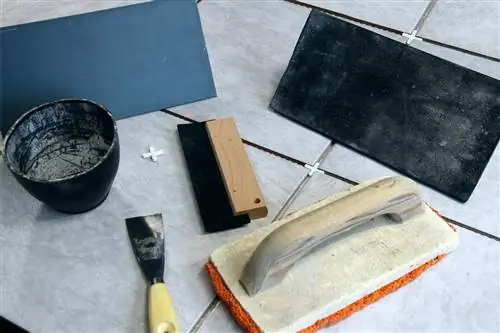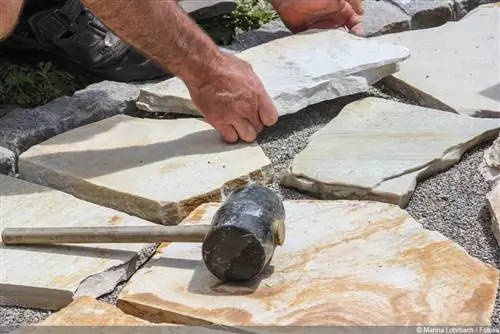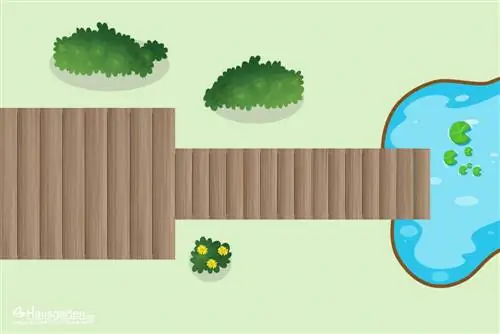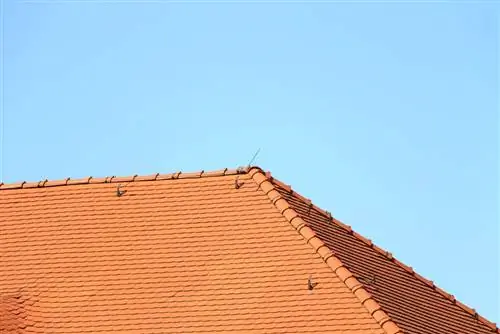- Author admin [email protected].
- Public 2023-12-17 03:39.
- Last modified 2025-01-24 12:45.
When it comes to wooden tiles, you can choose between real wood tiles, usually made of acacia wood and also made of high-quality wood-plastic composite materials, usually called wood-plastic composites (WPC for short). These tiles are extremely moisture and weather resistant. The UV resistance is also quite high. Golden acacia tiles are also available. However, it is African teak, also a hardwood with a good durability class. Robinia wood is often sold as acacia. This can only be determined if it is stated that the wood comes from domestic production. Acacias do not thrive in Central Europe, they are not hardy. Robinia wood is good wood and also has a good durability class. Wooden tiles made from pine, spruce and larch come from local production. However, this wood does not last that long.
Sizes
The tiles usually have a format of 30 x 30 cm. 11 tiles are required for one square meter. However, there are also other dimensions, for example 40 x 40 cm and 50 x 50 cm. Wooden tiles usually have the typical warm wood color, while WPC tiles are often offered in gray tones. Wooden tiles can be laid in different ways, conventionally like tiles or using a click system, similar to laminate. The latter type is becoming increasingly popular because it is extremely simple and requires no tools or other additional material to attach. Wooden tiles are mounted on special plastic panels. They are very precise and stable. The prices for one square meter of wooden or WPC tiles are around €25. The wood is acacia (mostly from Vietnam). Robinia wood is more expensive, around €10. Golden acacia is really expensive. Here the square meter costs around €70. Special offers at €2 per square meter should be viewed with caution. For the price it can't really be anything sensible, that's what common sense tells you. Not only is the quality often poor, the origin is also questionable. The wood usually comes from illegal mining areas and the workers are extremely exploited. There is no other way a price like this can come about.
Tip:
When buying wooden tiles, pay attention to the FSC seal. The wood comes from responsibly managed forests and not from overexploitation.
Laying wooden tiles
The easiest way to lay wooden tiles is on a solid surface. This works wonderfully on a balcony, for example. A clean, flat surface makes laying wooden tiles a breeze. Of course, it must be ensured that water can drain away and not that the tiles remain in water for a long time. They cannot tolerate constant wetness. In principle, the tiles can be laid well on the following surfaces: screed, concrete, concrete tiles, asph alt or ceramic tiles. With these floors, there are generally no unevennesses that need to be leveled out. They are straight, smooth and clean and can be occupied immediately.
Substructure?
Although the floor must be flat and smooth, wooden tiles do not actually require a special substructure. However, it is recommended to buy wooden tiles with a grid system underneath. This prevents the tile or wood from being permanently wet from below. This grid underneath is standard on high-quality wooden tiles. A substructure is not absolutely necessary, but one is often made of concrete, simply because a slope can then be installed and it is guaranteed that the tiles will permanently lie in the same position as they did immediately after they were laid out. Often only curbs or a socket are installed in concrete. Such an edging gives the surface a stable appearance and long durability.
Laying wooden tiles with the click system
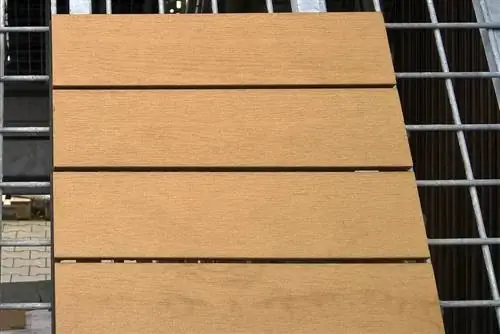
The tiles can be easily laid on a flat surface. First you lay them out loosely on the desired surface and push them close together. You can lay the tiles parallel or opposite, depending on the pattern you want to get. Staggered laying is also possible. It is important not to firmly attach the wooden tiles to the subsurface, as they can swell and shrink with changing weather conditions. It is therefore important to maintain a minimum distance of 10 to 15 mm from solid structures such as walls and door thresholds. For staggered laying, edge tiles must be cut. The easiest way to cut these tiles is to just cut through the plastic mesh underneath. If the wood also needs to be cut, work very cleanly and, if possible, cut into an existing “crack”. Do the same with the outside tiles. Connect all tiles firmly together, i.e. click them together. The surrounding edge looks better if it is screwed to suitable boards, of course only if no other edge solution has been prepared. It is important that the laid surface forms a solid unit and that no wooden tiles can become independent.
Laying wooden tiles without a click system
The same procedure is followed here. The difference is that these tiles usually do not have a substructure. This means the wood is in constant contact with the surface. This must be stopped. Therefore, the height compensation must be carried out with relining. Small pieces of wood or other fillers are suitable. The tiles must be lifted evenly. Another difference can be seen when cutting. To do this, attach a new support lath to the appropriate place and saw off the wooden tile at this point. The tiles can be easily cut and divided. A hand-held circular saw, for example, works well. The tiles are only laid loosely. The gap between the joints should be approximately 5 mm. They are not directly connected to each other.
Wooden tiles on lawn
When laying the lawn, the surface must be prepared accordingly. A root fleece is laid out directly on the lawn. This prevents grass or weeds from growing through the cavities in the wooden tile later. A layer of gravel about 5 cm thick should be spread on top, with a grain size of 0/30 or 0/45. The gravel evens out unevenness that is often present in lawns. Waves, dips and slopes should be avoided. Tiles laid on uneven surfaces are constantly under tension. If they are then put under strain, they tear easily and can even break. Make sure the gravel bed has a slight slope so that water can drain away.
Conclusion
Wooden tiles are easy to lay, at least on smooth surfaces. The tiles with the click system are particularly easy to install. In addition to a flat floor, an edge that prevents the tiles from slipping is important. Choosing the right tiles, especially the type of wood, is crucial for long-term beauty. You should also be aware that wood needs to be cared for. WPC tiles are easier to care for, but you can't do without them either.


